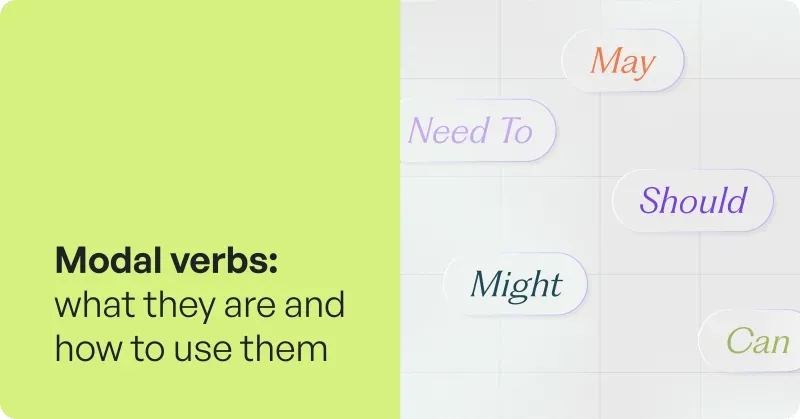How to Use Modal Verbs for Clear Communication
Admin / August 3, 2024

You likely found this post by asking “What’s a modal verb?”. In short, modal verbs are used in English to express possibility, permission, necessity, ability, obligation, and probability. But they can be confusing because they’re different from other verbs.
Mastering modal verbs is essential to communicating clearly and accurately in English, and I’m here to help. As a former English teacher and now freelance copywriter, I’ll draw on my experience to explain what modal verbs are and how to use them with confidence so your writing can really sparkle.
Summary of common modal verbs
Here’s a list of the most common modal verbs you can use — many of them in more than one context:
.webp)
What’s a modal verb?
A modal verb is a type of verb that expresses possibility, permission, necessity, ability, obligation, and probability. Common modals include “can,” “could,” “must,” “should,” “would,” “will,” or “may,” but we’ll explore them fully below.
Semi-modal verbs
“Need” and “ought to” are generally referred to as “semi-modal” verbs and are often used to express obligation and necessity.
“Need” can function as a pure modal verb or a main verb. However, it’s rare to use “need” as a modal, and even then, it tends only to be used in the negative or question form. When it’s used in the affirmative, it’s generally with a negative subject such as “nobody.” The example sentences below sound old-fashioned as a result:
“No one need speak.”
“You needn’t speak.”
“Need they speak?”
Nowadays, it’s more usual to use “need to” as a main verb followed by an infinitive to express necessity:
“I need to speak.”
“He doesn’t need to speak.”
“Do we need to speak?”
“Ought to” is semi-modal because, unlike full modal verbs, it always takes “to” before the infinitive. However, it doesn’t change according to the subject:
And the negative and question form are structured like full modal verbs. However, they’re rarely used and sound very formal:
Using modal verbs to talk about the past, present, and future
All modal verbs can refer to the present or future without changing. So, for example:
Only some modal verbs can refer to the past, e.g. “could” and “would.”
We can also talk about the hypothetical past using the modal with the verb “have” and the past participle. For example:
For a continuous action, we use the modal with the verb “be” and the -ing form of the main verb. In the present, this looks like:
In the past, this looks like:
When are modal verbs used?
Modal verbs are used to express possibility, permission, necessity, ability, obligation, and probability. As you’ll see below, some modal verbs can perform more than one of these functions.
Possibility
Modal verbs can help you express the degree of likelihood that something will happen. For example:
Permission
When we want to show that we have permission, we use the following modal verbs:
We can also use the modal verbs to ask for permission:
Necessity
We use the following modal verbs to convey how important it is for something to happen:
We can also use the semi-modal “need to” for this purpose:
Ability
We can use modal verbs to express our ability to do something, such as:
We can also use modal verbs to modify the phrasal verb “to be able to” to show when the ability is tentative or speculative:
Obligation
Modal verbs can express duty or responsibility. This is similar to necessity but can capture more of an external requirement. For example:
Semi-modals can also be used here:
Probability
Modal verbs can express how likely it is that something will happen:
Emphasis
You can also place emphasis on modal verbs to convey your meaning with particular strength. For example:
Future tense
The modal verb “will” is how we commonly express the future tense in English. For example:
How to check if you’re using modal verbs correctly
Once you’ve completed a piece of writing, it’s important to proofread carefully, including for grammatical errors. If you’re still not sure whether you’re using modal verbs correctly, try using AI software like Rewritai to find and correct any mistakes.
This can be much quicker and easier than checking yourself, as the software will automatically find and highlight any mistakes as well as giving a correction.
Conclusion
Now you know that modal verbs can be added to main verbs to help you convey possibility, permission, necessity, ability, obligation, and probability. They can also be used in different grammatical moods, such as the subjunctive, and to form the future tense with “will.”
Remember that modal verbs go before a main verb in the infinitive (without to) and don’t change according to the subject of the sentence (who is doing the action). They also don’t have tenses in the same way as other verbs. Finally, in addition to full modal verbs such as “might” or “can”, there are semi-modals that can behave both as modals and as main verbs verbs, for example, “need to” and “ought to.”
For more grammar tips, check out our blogs on double negatives and compound sentences.
FAQ
What are some common modal verbs?
Common modal verbs include “can,” “could,” “will,” “may,” “might,” “shall,” “should,” and “must.”
How do you identify the modal in a sentence?
The modal verb will go before the main verb to convey a sense of possibility, permission, necessity, ability, obligation, or probability.
What is the rule of modals?
A modal verb won’t change according to the subject of the sentence and doesn’t have different tenses (past, present, future, etc).